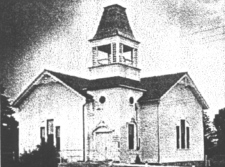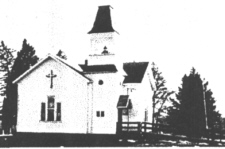|
|
 |
 |
|
|
 |
 |
A BRIEF HISTORY
of the
YORK CENTER UNITED METHODIST CHURCH
1880-2001
(Compiled by Jean Dahl from historical accounts from the 1980 Centennial Publication, old newspaper articles, and other recollections. Much of the content is written in the form of its originality).
|
Rev. J. P. Greer |
Adonijah Benedict |
OUR HISTORY--1880 - 2001
The history of York Center Church really began in 1872, with Rev. McLain as pastor receiving a salary of $500.00. The first church services in the area of York Center were apparently held in a schoolhouse near the County Farm. The County Farm was located between Neillsville and the present York Center Church on what is now County Road C. Many of the families had moved here from the southern counties of the state. They came in covered wagons, with little money to purchase land. They only found dense woods with few roads or trails and almost no bridges. Mr. & Mrs. Wm. Rowe and Walter were among the first. Land was purchased for one dollar an acre and on the land purchased log buildings were built and land prepared for farming. In 1873 a new log schoolhouse was built, one quarter mile west and one half mile north of the present church. Circuit riders held church services there until the new church was built. Adonijah Benedict and his family came to York Center that year. He became a leader in organizing the Sunday School and served as its leader.
In 1879, Greenwood/Loyal charge separated and became Loyal/ Spencer/ York Center charge. They were served by Rev. J. P. Greer until September 1881. He lived in Spencer and came on horse back to Loyal and York Center. He helped plan the building of the church with the help of Burt Lindsley and Burton Lawrence. They also plotted out the cemetery. The east wing of the church was built in 1880. Six acres of land was given to the community by the Fox River Lumbering Co. for the church and cemetery. The church was built from logs cut and sawed from this six acres. Many helped cut and haul logs to the mill, clear the land and hew out the blocks for the first foundation. The church was filled from the start with families coming from miles around. Home made benches and seats were made and placed around the edge and chairs were placed in the center. The pulpit and altar were added later. In 1884 Rev. G. N. Foster started the permanent records of Loyal and York Center. These early records were kept in Spencer and were later destroyed by fire in 1886. The first ministers until about 1884 only served a year at a time. The Sunday School in early years began at 1:00 PM and lasted I hour. At 2:00 PM the preacher presided for I hour, followed by what was called a class meeting. It was really a testimony meeting. A member of the church would go up and down the aisles and ask what was the condition of their soul, or how they were faring etc. This kind of put the members in a squeeze, as maybe you'd heard some of them getting their cows out of the com in the morning and it wasn't too peaceful. In cold weather, the congregation would set around the wood stove. After the pews were installed or during an afternoon service in warm weather, some of the older men's heads would nod and their eyes assumed a resting position.
The earliest mention of a name ( for the church) is in the conference yearbook of 1894. The district Sup't says in his report, "We have had two camp meetings in the District, one at York Center with much profit to that rural district". This location was previously known as Location 425, then it became Turner District, then Wilcox and later York Center. The York Center Camp meetings were held on the SW comer of IO acres leased from Wm Rowe that jointed the church ground. They met under a large tent and the meetings lasted for I week each summer.
The remodeling and enlarging of the church began during the pastorate of Rev. Knudsen in 1897. The changes consisted of an annex and belfry on the west, new windows, concrete steps at the entrance, new pews, new pulpit and bell. Rededication services were held in February 1899. The sheds that housed the horses during service were on the west side of the church. The first stall was the preachers, that was understood.
About this same time some members wanted an organ. Arguments arose as some of the congregation were absolutely against having music in the church. The church soon divided into 2 groups. George Lindsley took their organ from home and put it in the church. Those people not wanting the organ left and formed a new church which was called the Free Methodist Church. This church stood about one mile north of York Center church. Later a new Kimball was purchased and used for more then fifty years.
In 1903 York Center's $75.00 debt was paid.
Rev. W. J. James served as pastor from 1923-1927 and had served here as an assistant pastor in 1896. During that year he recalls that he was called the boy preacher of the conference. He couldn't vote until after his first service at York Center. Some of the changes during his ministry were: The Sunday dinner was prepared on Saturday so that there had to be no cooking on Sunday. It was considered wrong to shave on Sunday, or to blacken shoes. There were no baseball games on Sunday, no picnics were held on Sunday, and no Methodist would dance-ever.
In 1933 a new roof was put on the church.
In November of 1941 redecorating started on the interior of the church. NuWood was used and completely covered walls and ceiling. The NuWood cost was $250.00. New electric lights and an oil burner were added in 1947-1948. New altar carpet was laid in 1949 and in August the York Center church celebrated its 70' anniversary with over 200 people in attendance.
|
© Every submission is protected by the Digital Millennium Copyright Act of 1998.
Show your appreciation of this freely provided information by not copying it to any other site without our permission.
Become a Clark County History Buff
|
A site created and
maintained by the Clark County History Buffs
Webmasters: Leon Konieczny, Tanya Paschke, Janet & Stan Schwarze, James W. Sternitzky,
|